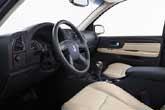Recent Articles
Popular Makes
Body Types
2006 Saab 9-7X First Drive
Saab’s SUV Swings – But Can it Do the Swedish Frog Dance?
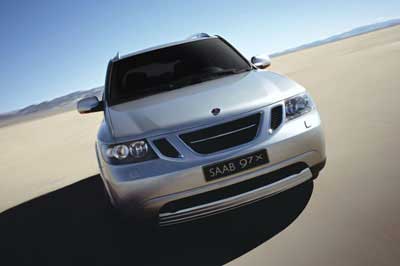
QUEBEC CITY, CANADA – Pulitzer Prize winner and noted New York Times columnist Thomas L. Friedman claims in his latest book that the world has gone flat, and after listening to Saab executives say to their new Swedish SUV built on an American truck platform in a Moraine, Ohio, assembly plant it was easy to see globalism at work. Saab was speaking to a small cadre of journalists assembled for the maiden media drive of the 2006 9-7X sport-utility in the province of Quebec, a charming, craggy land boasting unpolluted air and pure waters that is not much different from Saab’s homeland of Sweden. Plus, Quebec City is often considered the most European city on the North American continent, a fitting backdrop to our test drive since Saab is General Motors’ solo premium European brand.
What we came to see, however, was something far beyond the beautiful Canadian landscape. We came to see whether this proud Swedish marque could take GM’s four-year-old, mid-size SUV platform and wave its engineering wand to build an authentic Saab. Or if the 9-7X is simply just a tall, boxy, badge-engineered Buick dancing down the highway in a country that still loves sport utes.
During our 250-mile ride and drive, we ferreted out a few answers. Saab’s first SUV is now in production, endowed with sheetmetal and interior trim that are distinctively Saab. Its driver-oriented handling and level of safety equipment is up to par with most Saabs, which until recently were built exclusively in Sweden. But, there’s nothing Swedish about the sound that comes from the 9-7X’s powertrain. It’s an everyday American tune that plays out with some harshness, and therein lays the rub.
Model Mix
Model Mix The 2006 Saab 9-7X arrives in two strengths, both equipped with standard all-wheel drive. The entry-level model with the six-cylinder engine costs about $40,000, while the V8 version runs about $42,000. The 2006 Saab 9-7X arrives in two strengths, both equipped with standard all-wheel drive. Base models, priced at approximately $40,000, arrive with standard automatic climate control, leather-trimmed seats, eight-way power front seats with heaters, OnStar telematics, 18-inch wheels and tires, and front fog lamps. A 275-watt Bose audio system wired for XM satellite radio also comes standard, including a six-disc in-dash CD changer. Safety equipment includes side-curtain airbags, stability control, and OnStar telematics with a one-year Safe and Sound subscription that will send rescue personnel to your location in the event of an accident. The base engine is a 4.2-liter inline-six-cylinder yielding 290 horsepower and 277 lb.-ft. of torque. One of GM’s favorites, the four-speed Hydra-Matic automatic transmission, adequately handles shifting duties, though five- and six-speed automatics are becoming the norm in the luxury ‘ute class. Pricier V8 models, starting at approximately $42,000, add a 5.3-liter Vortec V8 delivering 300 horsepower and 330 lb.-ft. of torque. This engine is equipped with displacement on demand, technology that shuts down four of the motor’s eight cylinders under low power loads, accounting for up to a five percent fuel savings when compared to similar engines. Saab also changed the wheel design on V8 models and added power adjustable pedals, xenon high-intensity discharge headlights and headlight washers. Options for both models include a power moonroof and a rear DVD entertainment system, although the two cannot be ordered together, which is sure to be frustrating to luxury suv buyers. Of note, a small number of 2005 Saab 9-7X models have been built and shipped to dealers. Unlike the 2006 versions, these are marketed under the designators of Linear for the six-cylinder models and Arc to represent V8s. The 2005 Saab 9-7X Linear makes less power and torque than the 2006 model, and the 9-7X Arc lacks the fuel-saving displacement on demand feature. Neither of the 2005 versions have a standard stability control system. To mark the upgrades for 2006, the models will be called Saab 9-7X and 9-7X V8.
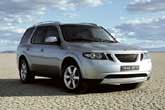
Nuts and Bolts
Nuts and Bolts Saab 9-7X models with a six-cylinder engine make 290 horsepower, while the V8 whips up 300 ponies. The big difference with the V8 is torque, of course, and for 2006, the bigger motor includes cylinder deactivation technology to save gas. Both engines in the 2006 Saab 9-7X are sourced from GM’s family of Vortec motors. The all-aluminum 4.2-liter inline-six features dual overhead cams, variable cam phasing, and four valves per cylinder. With an output of 290 horsepower at 6,000 rpm and 277 lb.-ft. of torque at 3,600 rpm, this engine bests the six-cylinder units offered in Land Rover’s LR3, BMW’s X5, Volvo’s XC90, and VW’s Touareg. All aluminum construction, overhead valves (two per cylinder), and a block-mounted cam help the 5.3-liter V8 create 300 horsepower and 330 lb.-ft. of torque. Saab’s horsepower-to-displacement figure diminishes by comparison, however, when looking at competing models that displace 4.4 liters but yield greater power and comparable torque – like the BMW, Land Rover, and Volvo. And, while the Volkswagen Touareg’s V8 displaces even less cylinder volume at 4.2 liters, it still delivers 310 horsepower and 302 lb.-ft. of torque. The numbers also favor the competition when comparing transmissions. A four-speed automatic, a durable and well-respected Hydra-Matic unit from GM, backs both Saab engines. However, the other manufacturers offer more gear ratios and wider choices. All Land Rover LR3s use a six-speed automatic, BMW features both five- and six-speed autos plus a six-speed manual, Volvo uses a six-speed unit on the V8 model, and VW sports a six-speed, as well. Standard AWD is in line with the competition, as is the 9-7X’s fully independent suspension. With firm front and rear shock absorbers, a sturdy 36-mm front stabilizer bar, and stiff rear upper control arm bushings, the 2006 Saab 9-7X has been tuned to handle more like a European touring car than an American SUV. Rack-and-pinion steering directs the large 18-inch wheels, wrapped in P225/55R18 Dunlop tires designed specifically for the 9-7X. Vented brake rotors measure 12-inches up front and 12.8-inches in the rear, and ABS is standard.
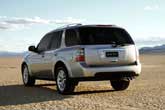
Design
Design Up front, the 2006 9-7X is all Saab. Viewed from the sides or rear, it’s easier to discern its GM origins. Inside, Saab has added a traditional cockpit-style dashboard, complete with Inspector Gadget dash-mounted cupholder and an ignition slot between the seats. Oncoming traffic will recognize the 2006 9-7X as a Saab product, thanks to its attractive exterior and the familiar three-port grille and upswept headlights. Saab has eliminated any sag in its new suv’s face by using prominent bumper creases, high-mounted headlights, and a lower air dam that, while clearly defining the underbody of the vehicle, also rises to merge aggressively with the front bumper. The trapezoidal shape of that lower air dam ties visually to the inverted trapezoidal shape of the grille, unifying the front end from top to bottom. It is a handsome vehicle. Step to the side of the 9-7X, however, and the Saab styling cues become less obvious. Forward slanting C-pillars and black D-pillars that blend in with the rear glass are also seen on the 9-2X and 9-5 Wagon, but the smaller size of those vehicles allows such design elements to resonate with more emphasis. Side arches flare to tastefully enunciate the wheels. At the rear, clear acrylic taillight lenses integrate nicely into the bodywork. Though a boxy resemblance to Buick’s Rainier, Chevy’s TrailBlazer, GMC’s Envoy, and the now-defunct Oldsmobile Bravada is apparent in the 9-7X’s flanks and tail, we would describe the Saab as the most attractive of all. The cockpit is where the 9-7X’s clean Scandinavian demeanor shines through. More traditionally Saab than the exterior, the smell of the 9-7X’s premium leather and the look of its fine wood and detailed overstitching are a delight to the senses, as is the green backlighting of the aircraft-inspired gauges. A driver-centric center control panel anchors dashboard contours that clearly define the front seating areas, while a four-spoke steering wheel with a trapezoidal airbag cover stands out as purely Saab – despite its basis on the tillers found in every other GM SUV. Saab even included its quirky cupholder design – like those on the 9-3 and 9-5 – to ensure the 9-7X’s credentials as a true Saab. A simple push brings it outbound, where it twists and swivels to add a third holder for beverages, along with the two cupholders incorporated into the center console. Uniquely and purely Saab is the center-mounted ignition, located on the center console between the seats.
Seat surfaces and bolstering are comfortable and the power adjustable pedals (V8 model) and front seats allow the driver to tailor a proper fit at the tilt wheel. While a third-row seat is unavailable in the Saab 9-7X, cargo space is plentiful, with over 80 cubic feet available with the rear seat folded. Land Rover, Volvo, and Mercedes all offer comparable space, while VW delivers nine fewer cubic feet and BMW trails by over 25 cubic feet.
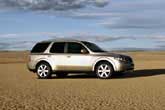
Safety and Technology
Safety and Technology Four-wheel-disc brakes with ABS, dual-stage front airbags with passenger sensing, and side curtain airbags come standard on every 2006 Saab 9-7X. The side curtain airbags include a rollover-sensing module. Four-wheel-disc brakes with ABS, dual-stage front airbags with passenger sensing, and side curtain airbags come standard on every 2006 Saab 9-7X. The side curtain airbags include a rollover-sensing module that triggers both the airbags and the seatbelt pretensioners when a rollover is imminent. This electronic system measures vertical and lateral acceleration, vehicle speed, and roll weight in its determination to deploy the airbags. A stability control system is also standard on 2006 models. The 9-7X also features a six-disc in-dash CD player with six premium Bose speakers as standard equipment. Audio controls are found both on the steering wheel and on the dash, as well as in back of the center console within reach of rear seat occupants. All passengers can control the volume on both the audio and available rear DVD entertainment systems. Unfortunately, Saab is unable to allow customers to order a power sunroof in tandem with the rear DVD entertainment system. Another creature-friendly feature, the dual-zone automatic climate control, is fitted with an electrostatic/carbon filter that removes particles from the incoming air, effectively blocking dust, pollen, soot, and harmful gases or vapors.
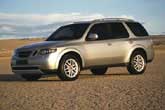
Driving Impressions
Driving Impressions In addition to its adjusted ride height, the Saab 9-7X features stiffer shocks, modified spring rates, improved frame strength, a thicker front anti-roll bar, and new bushings. These changes are calibrated to provide performance-oriented, European ride and handling quality. Our drive in the 2006 Saab 9-7X began in Quebec City, along the St. Lawrence Seaway, taking us from four-lane roadways to secondary roads with varied pavement surfaces, including both mountain routes and a forested back road. With a ride height that’s lowered by approximately one inch over its GM stablemates, the 2006 Saab 9-7X makes it easy to slip within the well-appointed – yet uncluttered – cockpit that has intuitive controls and Scandinavian design cues. After getting behind the wheel, you’ll find that there are numerous adjustments and changes to the Saab 9-7X’s underpinnings that make this a different-handling vehicle from other midsize GM SUVs, although, by comparison, the Saab drives most like the Buick Rainier, from which it gets its AWD system.
In addition to its adjusted ride height, the Saab 9-7X features stiffer shocks, modified spring rates, improved frame strength, a thicker front anti-roll bar, and new bushings. These changes are calibrated to provide performance-oriented, European ride and handling quality. Saab benchmarked the Volvo XC90 and the Saab 9-5 sedan for ride and handling, and we think comparison to the XC90 is far more accurate, since driving the 9-7X does not feel like driving sedan. On coarse road surfaces, the 9-7X feels like the SUV it is, although it earns praise for limited body roll and non-intrusive tire noise. And, despite the fact that feedback to the driver is more like a truck than a car, the 9-7X inspires confidence thanks to its overall responsiveness. Standard electronically controlled air springs with auto-leveling, a quicker steering ratio, and steering toe-in adjustments also contribute to the 9-7X’s improved precision. Large, four-wheel vented disc brakes with ABS have been improved for better pedal feel and response time, doing their duty with well-controlled stopping capability. The Saab 9-7X was the most fun to drive on hard-packed dirt. It was here that the standard limited-slip differential and all-wheel-drive system made it easy to toss around, controlled and predictable in all respects. We also tried out each of the powerplants, liking the six-cylinder model just fine. But we found that, in the V8 version, the four-speed automatic hunts and searches when under duress. Our only other complaint of note was the 9-7X’s exhaust tuning. It is neither pleasant, nor Scandinavian. It is harsh in a manner than undercuts the Saab’s other pleasantries.
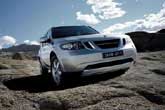
Wrap-Up
Wrap-Up Saab is too small to succeed on its own. Therefore, it must rely on the economies of scale available through General Motors, such as platform and parts-bin sharing with other GM brands. Nevertheless, the new 9-7X possesses Saab-ness, both inside and out. There are those who would say that this Swedish marque lost credibility and appeal when it added the Japanese-built 9-2X hatchback, a re-badged Subaru with all-wheel-drive and an ignition switch located on the steering column, to the lineup. But Saab is too small to succeed on its own. Therefore, it must rely on the economies of scale available through General Motors, such as platform and parts-bin sharing with other GM brands.
Regardless of loyalist moaning, the 9-2X has added much-needed sales to the Saab coffers, helping to preserve the brand as a viable business. Saab expects incremental gains from the 9-7X as well, hoping to sell approximately 7,000 copies of the 2006* version to its affluent, well-educated and knowledgeable customer base. And, it’s clear from the sales numbers that Saab must also become as popular in the Sunbelt as it is in the Snowbelt, so marketers will heavily target Los Angeles, Dallas, Miami and Atlanta for new sales while it expands the product line.
Bottom line, and most important to those loyal buyers that Saab seeks to retain while building a lineup with more diverse appeal, the new 9-7X possesses Saab-ness, both inside and out. And, as Saab’s first-ever SUV, it’s been engineered to give you a ride with feedback and control, a hallmark of Saabs past that were exclusively built in Sweden. We would tell you that despite the fact that it’s an American truck in Scandinavian clothing, it can do the traditional Swedish Frog dance, used by children and adults for fun and entertainment. It just shouldn’t try to sing. *Note that a handful of 2005 models trickled out of the factory before production on the 2006 9-7X began, and buyer beware because the 2005 model has slightly less power from its standard six-cylinder engine, the optional V8 lacks the 2006 model’s displacement-on-demand fuel saving technology, and it lacks standard stability control.
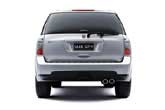
Specifications
Specifications The 2006 Saab 9-7X competes against the Acura MDX, BMW X5, Cadillac SRX, Infiniti FX35, Land Rover LR3, Lexus RX 330, Mercedes-Benz M-Class, Porsche Cayenne V6, Volkswagen Touareg, and Volvo XC90. 2006 Saab 9-7X; 2006 Saab 9-7X V8 $40,000 (6-cylinder) to $42,000 (V8) 4.2-liter inline 6-cylinder; 5.3-liter V8 275 at 6,000 rpm (6-cylinder); 300 at 5,200 rpm (V8) 275 lb.-ft. at 3,600 rpm (6-cylinder); 330 lb.-ft. at 4,000 rpm (V8) Four-speed automatic 4,612 (6-cylinder); 4,664 (V8) 15/21 mpg (6-cylinder); 14/18 mpg (V8) : 193.4 inches 75.4 inches 113 inches 70.5 inches 40.2 inches; 39.6 inches 44.6 inches; 37 inches Five 80.1 cubic feet 1,138 lbs. 6,500 lbs. (V8) 7.7 inches Acura MDX, BMW X5, Buick Rainier, Cadillac SRX, Chevrolet TrailBlazer SS, Chrysler Pacifica, GMC Envoy Denali, Hummer H3, Infiniti FX35, Jeep Grand Cherokee, Land Rover LR3, Lexus RX 330, Lincoln Aviator, Mercedes-Benz M-Class, Mercury Mountaineer, Porsche Cayenne V6, Subaru B9 Tribeca, Toyota Highlander Hybrid, Volkswagen Touareg, Volvo XC90
Photos courtesy of General Motors
